Pyxis (container)
A pyxis (Greek: πυξίς ; plural: pyxides) is a round container, usually a box with a lid. The name, which has been documented since Hellenistic times, comes from the Greek word pýxos for boxwood , from which pyxides were often turned. The Attic word kylichnís is probably an older name for it.
Not many wooden pyxides have survived today. Other materials are ceramic, alabaster , metal or ivory . They were used in the household of Greek women to store jewelry and cosmetics. That is why they are often painted in the red-figure style with scenes of women in their chambers. Pyxides were often used as grave goods for women.
history
The first variants of pyxides already existed in geometric times . These were large and flat and were probably used in a different way. In the 7th century BC The shape was further developed by Corinthian potters in order to adapt it to the new forms of decoration ( black-figure vase painting ). In the 6th century BC There were some further developments and special forms such as tripod and Nicosthenic pyxids. In classical times, a variant called Type A with a concave, steep wall dominated. In addition, type B , for which there was a slip lid, was also popular. In the Hellenistic period, the vessels grew taller.
From the Constantinian Age, pyxids made mainly of ivory were used as sacred ceremonial vessels for storing incense, relics and hosts. Outwardly, they were usually decorated with reliefs of biblical scenes.
Ancient ceramic pyxide molds
| Type | variant | comment | Redrawing | example |
|---|---|---|---|---|
| Horse pyxis |

|
|||
| Handle pyxis |
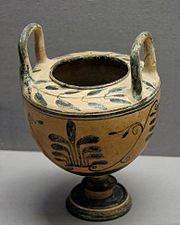
|
|||
| Ball pyxis |

|
|||
| Corinthian pyxis |

|
|||
| Attic pyxis | ||||
| Type a |

|

|
||
| Type B |

|
|||
| Type c |
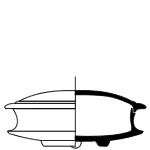
|
|||
| Type D |

|
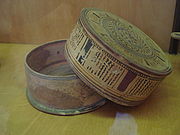
|
||
| Nicosthenic pyxis | Developed in the workshop of the potter Nikosthenes |
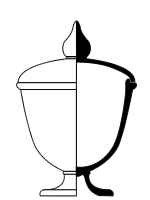
|
||
| Tripod pyxis |
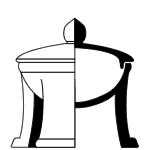
|
|||
| Apulian pyxis |

|
|||
| Double pyxis |

|
Web links
Individual evidence
- ↑ Joseph Sauer : The early Christian ivory sculpture . EASeemann, Leipzig 1922, p. 5 ( BdK 38 )
